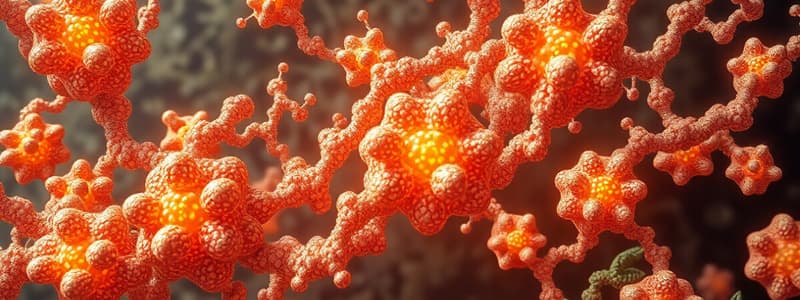Podcast
Questions and Answers
What is the term for the complex formed when an enzyme and its substrate bind together?
What is the term for the complex formed when an enzyme and its substrate bind together?
Enzyme-substrate complex
What type of bonds are predominant in the structural integrity of enzymes, especially in maintaining their shape?
What type of bonds are predominant in the structural integrity of enzymes, especially in maintaining their shape?
Intramolecular bonds
What is the role of cofactors in enzymatic reactions?
What is the role of cofactors in enzymatic reactions?
Cofactors assist in catalyzing biological reactions.
Which type of coenzyme is derived from vitamins and works loosely with enzymes?
Which type of coenzyme is derived from vitamins and works loosely with enzymes?
What is the state of an enzyme when its cofactor is not attached?
What is the state of an enzyme when its cofactor is not attached?
What is the site where a non-competitive inhibitor attaches to an enzyme?
What is the site where a non-competitive inhibitor attaches to an enzyme?
Define the term 'redox' in biochemical reactions.
Define the term 'redox' in biochemical reactions.
What happens to electrons when a molecule is oxidized?
What happens to electrons when a molecule is oxidized?
In the context of enzymes, what model describes a rigid structure that allows only specific substrates to bind?
In the context of enzymes, what model describes a rigid structure that allows only specific substrates to bind?
What major event occurs during the cell's oxidation of glucose?
What major event occurs during the cell's oxidation of glucose?
What type of molecules do NAD + and NADH represent in terms of oxidation and reduction?
What type of molecules do NAD + and NADH represent in terms of oxidation and reduction?
What role do catalytic groups or residues play in enzyme activity?
What role do catalytic groups or residues play in enzyme activity?
True or false: Enzymes are consumed during the chemical reaction they catalyze.
True or false: Enzymes are consumed during the chemical reaction they catalyze.
What role does the active site of an enzyme play in enzyme-substrate binding?
What role does the active site of an enzyme play in enzyme-substrate binding?
Explain why the shape of an enzyme is more important than its length for enzyme-substrate binding.
Explain why the shape of an enzyme is more important than its length for enzyme-substrate binding.
What is the function of an oxidoreductase enzyme, and provide an example?
What is the function of an oxidoreductase enzyme, and provide an example?
Define the role of a coenzyme and provide two examples.
Define the role of a coenzyme and provide two examples.
Describe the function of lyases and give an example.
Describe the function of lyases and give an example.
What is the role of coenzymes in enzyme activity?
What is the role of coenzymes in enzyme activity?
Define a holoenzyme.
Define a holoenzyme.
How does the presence of activators influence enzyme activity?
How does the presence of activators influence enzyme activity?
What must be attached to an apoenzyme for it to function?
What must be attached to an apoenzyme for it to function?
Name the two models that describe enzyme-substrate interactions.
Name the two models that describe enzyme-substrate interactions.
What distinguishes competitive inhibitors from non-competitive inhibitors in enzyme activity?
What distinguishes competitive inhibitors from non-competitive inhibitors in enzyme activity?
How many digestive enzymes are produced in the human body, and what is their significance?
How many digestive enzymes are produced in the human body, and what is their significance?
Explain the nature of specificity in enzymes.
Explain the nature of specificity in enzymes.
Flashcards
Enzyme
Enzyme
A protein that speeds up chemical reactions in the body without being consumed in the process. They are highly selective and control reactions in cells.
Substrate
Substrate
The molecule that an enzyme binds to and acts upon.
Enzyme-Substrate Complex
Enzyme-Substrate Complex
The temporary structure formed when an enzyme binds to its substrate.
Cofactor
Cofactor
Signup and view all the flashcards
Coenzyme
Coenzyme
Signup and view all the flashcards
Active Site
Active Site
Signup and view all the flashcards
Prosthetic Group
Prosthetic Group
Signup and view all the flashcards
Lock and Key Model
Lock and Key Model
Signup and view all the flashcards
What is the most important factor for efficient enzyme-substrate binding?
What is the most important factor for efficient enzyme-substrate binding?
Signup and view all the flashcards
What does an Oxidoreductase enzyme do?
What does an Oxidoreductase enzyme do?
Signup and view all the flashcards
What is a Lyase?
What is a Lyase?
Signup and view all the flashcards
What is an Isomerase?
What is an Isomerase?
Signup and view all the flashcards
What are Coenzymes?
What are Coenzymes?
Signup and view all the flashcards
Non-Competitive Inhibitor
Non-Competitive Inhibitor
Signup and view all the flashcards
Allosteric Site
Allosteric Site
Signup and view all the flashcards
Redox Reaction
Redox Reaction
Signup and view all the flashcards
Reduced Molecule
Reduced Molecule
Signup and view all the flashcards
Oxidized Molecule
Oxidized Molecule
Signup and view all the flashcards
Induced Fit Model
Induced Fit Model
Signup and view all the flashcards
Catalytic Groups (or Catalytic Residues)
Catalytic Groups (or Catalytic Residues)
Signup and view all the flashcards
Study Notes
Enzymes - Types of Enzymes Reviewer
- Enzymes are selective, controlling chemical reactions within cells.
- Enzymes are composed of proteins.
- Substrate is the molecule that binds to the enzyme.
- Enzyme-substrate complex forms when the enzyme and substrate meet.
- Products are formed when the enzyme and substrate undergo a reaction.
- Enzymes are typically globular in shape.
- Enzyme structure involves intramolecular and intermolecular bonds.
- Intramolecular bonds are strong bonds within a single molecule.
- Intermolecular bonds are weak bonds between separate molecules.
- Cofactors (or helper molecules) are non-protein chemical compounds that aid enzymes in biological reactions.
- Organic cofactors are prosthetic groups and coenzymes.
- Inorganic cofactors are metallic ions.
- An enzyme without cofactors is inactive.
- Coenzymes are loosely bound to enzymes and can carry or shuttle chemical groups between enzymes.
- Coenzymes are derived from vitamins.
- Holoenzyme is the complete functional enzyme, containing the apoenzyme and the cofactor.
- Apoenzyme is the inactive enzyme without the cofactor.
- Prosthetic groups are firmly bound to proteins.
- Activation energy is the energy needed to start a chemical reaction.
- Enzyme activity is affected by concentration of the enzyme.
- Active site is the location where enzymes and substrates bind.
- Coenzymes temporarily bind to the active site, enhancing protein charge.
- Two models describe enzyme-substrate interaction: Lock and Key, and Induced Fit.
- The Lock and Key model (proposed by Emil Fischer in 1894) suggests a precise fit between enzyme and substrate.
- The Induced Fit model (proposed by Daniel Koshland in 1958) suggests the active site changes shape to accommodate the substrate.
- Inhibitors interfere with enzyme function, hindering enzyme-substrate binding.
- Competitive inhibitors mimic substrates, competing for the active site.
- Non-competitive inhibitors bind to allosteric sites, changing the enzyme's shape.
- Redox reactions involve electron loss or gain. Reduction is gaining electrons, Oxidation is losing electrons.
Enzyme Classification
- Oxidoreductases catalyze redox reactions (electron transfer).
- Transferases transfer functional groups between molecules.
- Hydrolases use water to break chemical bonds.
- Lyases remove atoms or groups from substrates without using water.
- Isomerases rearrange atoms within a molecule.
- Ligases join two molecules, usually using ATP energy.
Enzyme Action Examples
- Examples of enzymes (and their types) are given:
- Glucose is a reduced molecule.
- NAD+ is an oxidized molecule.
- NADH is a reduced molecule.
- Oxidation leads to loss of electrons.
- Reduction leads to gain of electrons.
- Energy is released when glucose is oxidized in cells.
Studying That Suits You
Use AI to generate personalized quizzes and flashcards to suit your learning preferences.




